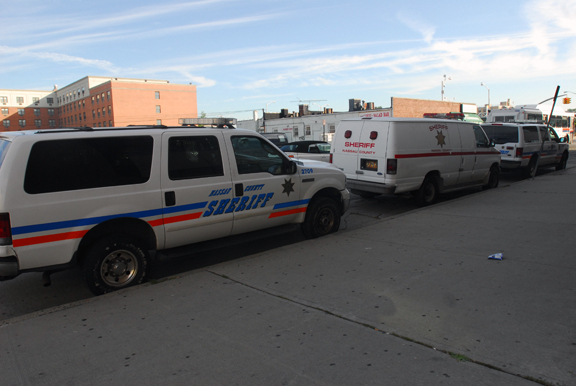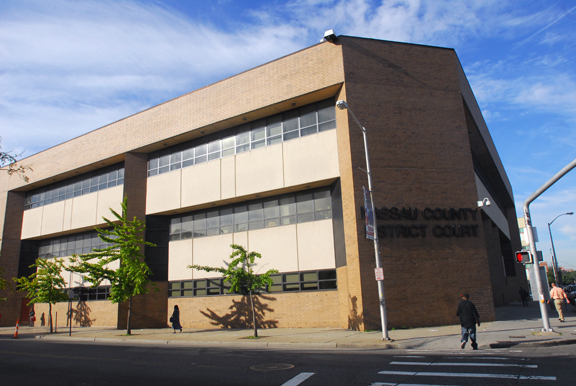The aftermath of a DWI arrest
Part two of a series.
A crash or a death. When caused by a drunk driver, the media is often all over it. But last week I went behind bars at Nassau County Police Headquarters to get an inside look at the less-publicized side of a DWI arrest.
Police simulated my arrest and took me through every step of the process, including leaving me locked in a cell where, under graver circumstances, I would have awaited transportation to my arraignment. I was never drinking, and at the end of the day, I walked away a free woman. Had my arrest been real, I would have spent the night in a cell and been taken in handcuffs via police transfer van to First District Court in Hempstead.
Though the ordeal was simulated, it was trying nevertheless. And a few days later, I headed to Hempstead to find out what happens after an arrest.
The holding cells
I met Eric Phillips, spokesman for District Attorney Kathleen Rice, at his office in Mineola. Ironically, I learned I wouldn't have the chance to meet with Rice herself because a nun named Lauren Hanley had allegedly just crashed her car in Wantagh while drunk, narrowly missing a group of kids. The case was keeping Rice, who has aggressively cracked down on drinking and driving since she took office in 2006, very busy.
Instead of a transfer van, Phillips led me to an unmarked police car and drove me to First District Court in Hempstead. The building was crowded with police and people dressed in suits, and in a bright hallway upstairs, people waited on benches and paced outside courtrooms. But then I was taken to where the transfer vans unload prisoners. In single-sex groups, arrestees are brought from a garage down narrow, dimly lit stairs to a hallway of holding cells with blue-painted bars.
It was a completely different atmosphere from the professional world at work upstairs. Police lined the walls, and well-dressed lawyers walked among the large concrete cells. All prisoners wait in the same cells, regardless of what they are accused of, with suspected murderers sometimes sitting beside drunk drivers, I was told.  Public defenders consulted with clients through the bars as I was led to a back room where prisoners are searched again after being brought over from Mineola. An incense stick was burning to mask the smell of unwashed bodies.
Public defenders consulted with clients through the bars as I was led to a back room where prisoners are searched again after being brought over from Mineola. An incense stick was burning to mask the smell of unwashed bodies.
Suspects are brought down to this hall while they wait to be arraigned upstairs. What happens next, in court, determines whether they are brought back down and locked up again or walk away on their own.
The arraignment
Upstairs, prisoners sit in their own section of court separated by plexiglass. Directly across from them, a row of prosecutors wait to argue each case. A judge sits at one end of the floor between them, and there are rows of benches for onlookers at the other end. In the center, suspects say their piece and are told their fate.
Behind the courtroom is another hallway that most people don't see, with offices where prosecutors sit and prepare each case. The county’s DWI deputy bureau chief, Assistant D.A. Laura Carroll -- whom Phillips called the “DWI czar” -- explained to me that in DWI cases, prosecutors' arguments in court have less to do with strategy than with preset legal guidelines. This is where the details of an arrest come into play.
"Usually on a first-time arrest, with no accident, you're likely to be released on your own recognizance," Carroll explained. But anything more serious than that -- an “aggravating factor” -- affects the bail recommendation and increases a suspect’s likelihood of jail time. Among the things prosecutors consider are how likely an individual is to return to court, prior arrests, and whether an accident was involved.
Being arrested with a blood alcohol content higher than .18 typically results in a recommendation of around 10 days of jail time, Carroll said. If you are arrested driving with a BAC over .08, your license is automatically revoked, with no opportunity to apply for a conditional license, a document that allows you to drive to certain locations, such as school or work, along approved routes, for 30 days, unless a special hearing is granted. The arraignment hearing lasts a few minutes, and determines bail and a new court date. Pleas and litigation take place upstairs, months later, in the large corridor outside an office Carroll shares with other prosecutors.
The arraignment hearing lasts a few minutes, and determines bail and a new court date. Pleas and litigation take place upstairs, months later, in the large corridor outside an office Carroll shares with other prosecutors.
The aftermath
An arrest and an arraignment may seem like a traumatic experience, but it's what happens when you’re out on your own, and possibly back behind the wheel, that the district attorney's office is concerned with. "I think what we're trying to do in Nassau County is change the culture of drinking and driving," Carroll said. "We don't want to give someone a slap on their wrist. We want to give them something they'll carry with them for the rest of their lives."
According to Carroll, every DWI plea in the county comes with a treatment provision. Each arrestee is evaluated and referred to a treatment program. A free program called Nassau County Screening Treatment Education and Prevention, or STEP, helps match treatment seekers and providers. The cost of treatment, however, is borne by individuals or their insurance companies, not taxpayers, Carroll said.
The procedures for dealing with underage drunk drivers place a greater emphasis on rehabilitation and prevention. Before 2007, being younger than 21 was considered an aggravating factor in a DWI arrest -- roughly the same, in the eyes of the law, as causing an accident or driving with a BAC over .18. But on Labor Day 2007, a program kicked off that gives underage drivers the opportunity to reduce their sentences by meeting a series of requirements.
The driver must first plead guilty to misdemeanor DWI, Carroll said. If there are no other aggravating factors in the case, an underage driver who agrees not to drive or get arrested for six months, to complete 50 hours of community service, including talking about DWI arrests at high schools, and to enroll in STEP will be pleaded down to a traffic violation. The program, Carroll said, has a 66 percent completion rate, and no one who has successfully completed it has been arrested for DWI again.
But make no mistake: DWI is a serious charge in Nassau County. And Rice's hard line on the issue has attracted attention nationwide. She was featured on CBS's "60 minutes" after she successfully prosecuted drunk driver Martin Heidgen for second-degree murder. Heidgen drove drunk in the wrong direction on the Meadowbrook Parkway, smashing into a limousine and killing its driver and 7-year-old Katie Flynn of Lido Beach, who was on her way home from a wedding with her family. Rice successful pushed for state legislation that now makes it easier to sentence drunk drivers who kill to longer prison sentences.
Phillips and I walked back to the car after we finished the tour. He put the key in the ignition, flicked his wrist, started the car and drove away from the many others, locked inside, who would spend years paying for their decisions to do the same after drinking.

 54.0°,
Overcast
54.0°,
Overcast 







